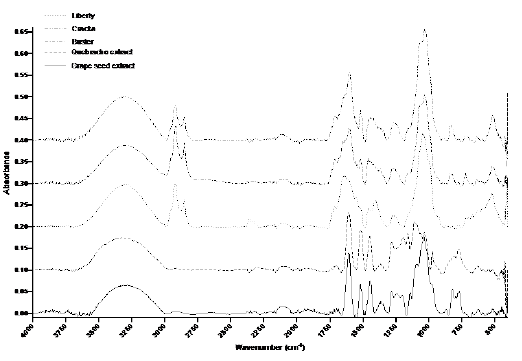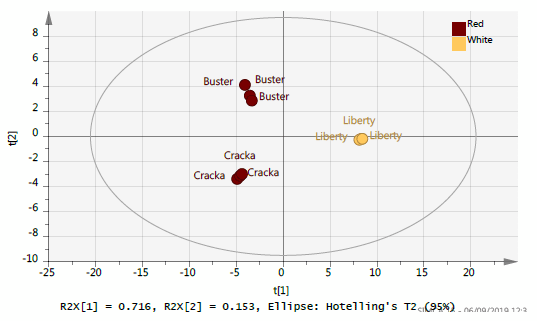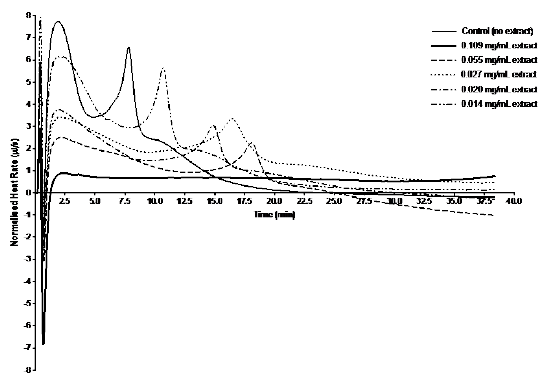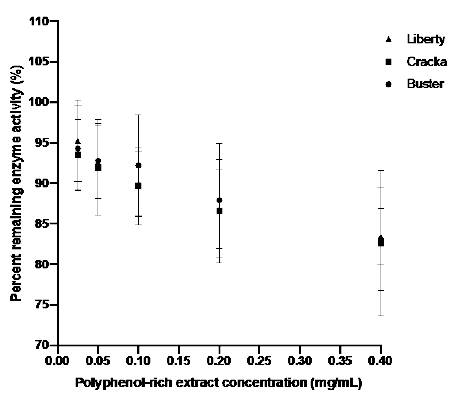I. INTRODUCTION
While the inclusion of feed enzymes is routine in poultry fed sorghum-based diets, the effects of these enzymes are often muted or substandard, especially with phytase (Selle et al., 2018). The exact mechanism for this underperformance is not known, however, it is most likely caused by one or all of three key endogenous grain components: kafirin, phytate and phenolic compounds. Phenolic compounds, routinely identified in sorghum, are known to be antinutritional, especially with regard to animal nutrition (Velickovic and Stanic-Vucinic, 2018). This antinutritional effect comes through precipitation of macromolecules thus limiting digestibility, interactions with the complex grain matrix and interference with digestive enzymes. Higher molecular weight compounds such as condensed and hydrolyzable tannins are thought to be one of the culprits of these effects (Bravo, 1998).
Feed manufacturers must take these potential interactions into account when preparing grain and formulating feed mixtures to include exogenous enzymes. Modern Australian varieties have been bred to reduce tannin content and are, for the most part, considered to be tannin-free (Selle et al., 2018). While ‘tannins’ in the traditional sense may be significantly reduced in modern varieties, ‘non-tannin’ phenolics are very much still present and have the potential to produce anti-nutritional effects (Liu et al., 2015). These phenolics along with kafirin and phytate may be interacting in complex ways that might reduce the effectiveness of feed enzymes, overall digestibility and energy utilisation. Therefore, a thorough analysis of the complex matrix and its components can lead to better understanding of the grain’s role in animal feed and ways to increase its performance and profitability.
II. METHOD
MR -Buster (Buster), Cracka and Liberty sorghum were provided by DSM Nutritional Products and harvested in 2017 in Queensland. Phytase and serine protease feed enzymes were also provided by DSM. Sorghum grain was defatted and extracted for polyphenols using 70% aqueous acetone following Harbertson et al. (2014). The Folin-Ciocalteu (F-C) method, following Ainsworth and Gillespie (2007), was used to determine the total phenolic content (TPC) of the polyphenol-rich extract. Commercial extracts were kindly provided by Silvateam (Italy). FT-IR analysis was performed using a diamond ATR crystal between the wavenumbers 4000 and 400 cm-1. Mass spectrometry was performed on a Waters Synapt G2-Si MALDI-ToF and ESI-ToF mass spectrometer. The effect of sorghum polyphenol-rich extracts on phytase activity was determined through ITC. ITC analysis was conducted using a TA Analysis NanoITC (TA Instruments, New Castle, DE). The injection syringe contained 20 mM phytate and was titrated into a mixture of sorghum polyphenol-rich extract and phytase over two injections, two and five µL, at 30℃, pH 5.0 ± 0.2 and 285 rpm stirring speed. The sample cell contained phytase, 4.075 FYT/mL, alone or with a range of sorghum polyphenol-rich extracts. The effect of sorghum polyphenol-rich extracts on serine protease activity was determined by colourimetric enzyme activity assay using a small, synthetic substrate.
III. RESULTS
Twenty grams of defatted sorghum were extracted with 70% aqueous acetone and freeze-dried. Table 1 shows the extracts quantified as grams of polyphenol extract per kilogram of grain (g/kg) and as TPC in milligrams gallic acid equivalent per gram of extract (mg GAE/g). Liberty was found to have a significantly (P < 0.001) lower TPC than both red sorghums, Buster and Cracka.
Table 1 - Quantification of sorghum polyphenol-rich extracts.
FT- IR analysis indicated the spectra for sorghum extracts matched closely to each other and shared similar features to two commercial extracts, quebracho and grape seed, known to contain tannins (Figure 1). Analysis by MALDI-ToF-MS allowed for the clear separation between red and white sorghum through principal components analysis (PCA) (Figure 2). ESI-MS2 provided tentative identifications of compounds present in the extracts to find primarily fatty acids, polyphenols and lignin-like compounds, including caffeoyl, feruloyl and coumaroyl glycerol esters.
Figure 1 - FT-IR spectra of sorghum polyphenol-rich extracts and commercial extracts.
Figure 2 - PCA plot from MALDI-ToF-MS of sorghum polyphenol-rich extracts.
The presence of sorghum polyphenol-rich extracts inhibited phytase activity up to 100% in the ITC in vitro model (Figure 3) whereas serine protease inhibition was limited to 20-30% (Figure 4). Liberty and Cracka inhibited phytase the most. Inhibition of the serine protease was found to be mixed non-competitive.
Figure 3 - ITC monitoring of phytase inhibition by Liberty extract.
Figure 4 – Percent inhibition of serine protease activity by sorghum extracts
IV. DISCUSSION
Polyphenol-rich extracts prepared from three Australian sorghums (Liberty, Buster and Cracka) were found to contain low to intermediate levels of phenolics and tentatively identified lignin-like derivatives, often associated with cross-linking polysaccharides in the cell wall matrix (Hatfield et al., 2017). Taylor (2005) has suggested these types of phenolics may hinder normal digestion. Further analysis of the polyphenol-rich extract including LC-MS is still needed to isolate specific compounds of interest. Phytase proved much more susceptible to inhibition than the serine protease and was inhibited most by Liberty and Cracka. This inhibition may explain the muted responses often seen in sorghum diets dosed with phytase (Selle et al., 2018). It is possible that in in vivo conditions phenolic compounds in sorghum may only partially inhibit phytase activity which could contribute to variance in digestible phosphorus yield, especially when low phytase inclusion concentrations are used. In addition to direct enzyme inhibition, phenolics may interact with phytate in vivo either directly or indirectly through phytate-starch/kafirin complexes. Phenolics and phytate have been found to positively correlate, most likely due to their proximity in the aleurone layer (Selle et al., 2018). Effects under more commercial conditions still need to be investigated and whether these in vitro responses can be replicated in vivo is uncertain. Serine protease, on the other hand, was least inhibited by Liberty and most by Buster. Inhibition values of the serine protease approached 30% indicating that even at high levels of polyphenol inclusion the enzyme remained robust and maintained sufficient activity.
ACKNOWLEDGEMENTS: We would like to thank Dr. Heather Walker in the biOMICS Facility in the Faculty of Science at the University of Sheffield for her assistance with mass spectrometry methodology and analysis.
Presented at the 30th Annual Australian Poultry Science Symposium 2020. For information on the next edition, click here. 















.jpg&w=3840&q=75)